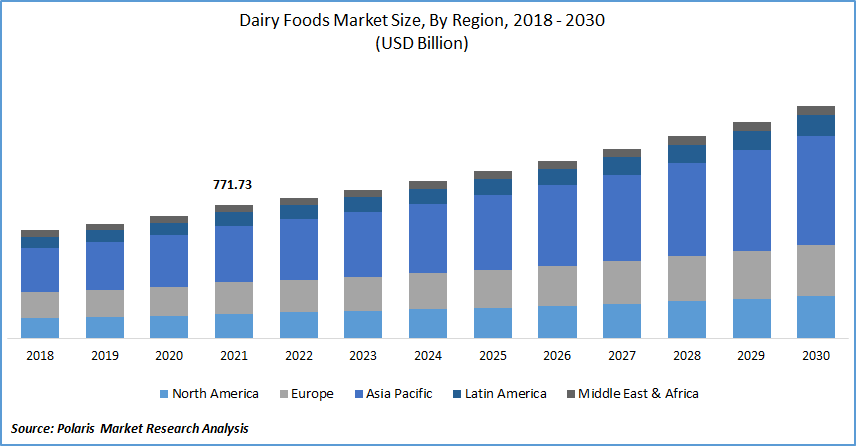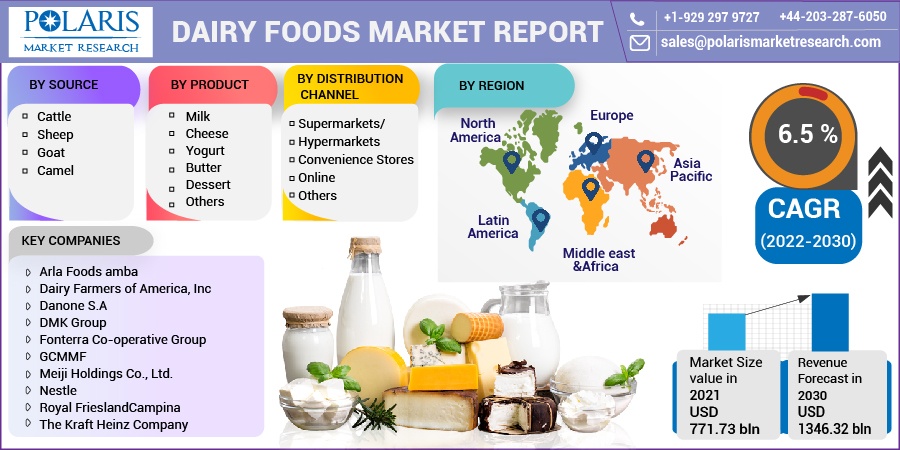
Dairy Foods Market Share, Size, Trends, Industry Analysis Report, By Source (Cattle, Sheep, Goat, Camel); By Product (Milk, Cheese, Yogurt, Butter, Others); By Distribution Channel; By Region; Segment Forecast, 2022 - 2030
- Published Date:Jun-2022
- Pages: 119
- Format: PDF
- Report ID: PM2458
- Base Year: 2021
- Historical Data: 2018 - 2020
Report Outlook
The global dairy foods market was valued at USD 771.73 billion in 2021 and is expected to grow at a CAGR of 6.5% during the forecast period. The industry is anticipated to grow at a faster rate owing to rising milk consumption and a shift in consumer preferences from meat to dairy foods for protein enrichment.
Know more about this report: Request for sample pages
These products are essential for keeping a balanced diet and lowering the risk of major illnesses. A healthy lifestyle and nutrition can help avoid a number of health conditions such as high blood pressure, obesity, cardiovascular disease, digestive problems, and type 2 diabetes. Furthermore, the easy availability of such products as a result of the development of emerging retail facilities and cold chain logistics is also contributing to the demand for the industry. The growing demand for these products is being driven by a large growth in sales of milk food products through online distribution.
The outbreak of the Covid-19 pandemic had a significant impact on the demand for the dairy foods market. Worldwide lockdown and stringent regulations caused an increasing number of people to be confined in their houses, allowing consumers to spend more time in their kitchens, resulting in an increase in household consumption of these products. Owing to its wide range, demand for categories such as cheese, yogurt, milk, and paneer increased significantly.
Furthermore, the pandemic has encouraged consumers to adopt a healthier eating regime. Consumer preferences have evolved toward the consumption of milk-based products, which created lucrative opportunities for manufacturers to enhance their product offerings. Manufacturers converted the surplus milk into highly demanded value-added dairy foods such as butter, paneer, ghee, cheese, and sweets, further enhancing the dairy foods market.
The Dairy Foods Market report details key market dynamics to help industry players align their business strategies with current and future trends. It examines technological advances and breakthroughs in the industry and their impact on the market presence. Furthermore, a detailed regional analysis of the industry at the local, national, and global levels has been provided.
However, the COVID-19 epidemic has significantly impacted the dairy foods market supply chain. In terms of both production and consumption of these products, several countries witnessed a decrease in demand owing to manpower shortages and disruptions in raw materials supply that halted dairy foods manufacturing.
Industry Dynamics
Growth Drivers
The demand for dairy foods market is fueled by the health benefits associated with their consumption. They are high in carbohydrates, protein, calcium, phosphorus, potassium, vitamin A, vitamin D, riboflavin, niacin, and other nutrients, which provide a variety of health benefits.
One of the important reasons driving the industry growth is consumers' increasing awareness of health and the consumption of healthy foods to maintain good health. These products are commonly consumed to improve overall health and well-being. In addition, there has been a considerable increase in the number of people who follow a vegetarian diet, which is driving up the demand for milk products to meet the diet's protein requirements.

Know more about this report: Request for sample pages
Report Segmentation
The market is primarily segmented based on source, product, distribution channel, and region.
|
By Source |
By Product |
By Distribution Channel |
By Region |
· |
· |
· |
|
Know more about this report: Request for sample pages
Insight by Product
Based on the product segment, the milk segment is expected to be the most significant revenue contributor. With the population expansion, rising incomes, rapid urbanization, and dietary changes, demand for milk and milk products are increasing in emerging countries.
This trend is highly evident in East and Southeast Asia, especially in densely populated nations such as India, China, Indonesia, and Vietnam. Growing demand for milk and milk products provides an excellent opportunity for producers in high-potential, peri-urban areas to improve their livelihoods through increased production.
Insight by Distribution Channel
Based on the distribution channel, the online segment is expected to witness the fastest CAGR growth during the forecast period. The segment growth is attributed to the rising development of online platforms across the globe. Online grocery sales are rapidly expanding, which is providing customers with easy buying of these products at affordable prices at times.
Geographic Overview
Asia Pacific had the largest revenue share in the global market. Rising demand from developing economies such as India and China are propelling the growth of the industry in the region. The market is growing due to rising awareness about healthy lifestyles and wellbeing, rising disposable income, and the availability of high-quality dairy foods in a wide range.
Furthermore, the rising government initiatives of various nations present across the region to further expand the dairy foods sector is another factor contributing to the market demand. In June 2020, the Government of India, in collaboration with the Department of Animal Husbandry and Dairying, announced a $ 2.1 billion infrastructure development fund with an interest subsidy scheme to encourage private sector and MSMEs investment in dairy foods.
Moreover, North America is expected to witness a high CAGR in the global market. Some industry categories have benefited from changes in consumer behavior brought on by COVID-19, such as the increasing usage of digital channels. The increased sale of dairy foods in the region is accelerated by the rising health awareness among consumers about the importance of adopting nutritious eating habits.
Many firms are focusing on developing new products for consumers as people's willingness to try out new and innovative products increases. The launch of numerous innovative yogurt products, such as fat-free, flavored, and drinkable yogurt, is expected to offer up new growth avenues for the market's makers.
Competitive Insight
Some of the major players operating in the global market include Arla Foods amba, Dairy Farmers of America, Inc, Danone S.A, DMK Group, Fonterra Co-operative Group, GCMMF, Meiji Holdings Co., Ltd., Nestle, Royal FrieslandCampina, and The Kraft Heinz Company.
In 2021, Nestlé launched Wunda, a new pea-based beverage that is an excellent source of protein and fiber. Its great neutral taste, its various applications, and the fact that it is carbon neutral make it an ideal plant-based alternative to milk.
Dairy Foods Market Report Scope
|
Report Attributes |
Details |
|
Market size value in 2021 |
USD 771.73 Billion |
|
Revenue forecast in 2030 |
USD 1,346.32 Billion |
|
CAGR |
6.5% from 2022 - 2030 |
|
Base year |
2021 |
|
Historical data |
2018 - 2020 |
|
Forecast period |
2022 - 2030 |
|
Quantitative units |
Revenue in USD Billion and CAGR from 2022 to 2030 |
|
Segments covered |
By Source, By Product, By Distribution Channel, By Region |
|
Regional scope |
North America, Europe, Asia Pacific, Latin America, Middle East & Africa |
|
Key companies |
Arla Foods amba, Dairy Farmers of America, Inc, Danone S.A, DMK Group, Fonterra Co-operative Group, GCMMF, Meiji Holdings Co., Ltd., Nestle, Royal FrieslandCampina, and The Kraft Heinz Company |
Navigate through the intricacies of the 2024 Intelligent Dairy Foods Market with precision, thanks to the comprehensive statistics on market share, size, and revenue growth rate assembled by Polaris Market Research Industry Reports. This thorough analysis not only provides a glimpse into the historical context but also extends its reach with a market forecast outlook until 2032. Immerse yourself in the richness of this industry analysis by securing a complimentary PDF download of the sample report.
Browse Our Top Selling Reports
Paprika Oleoresin Market Size, Share 2024 Research Report
Orthopedic Contract Manufacturing Market Size, Share 2024 Research Report
Residential and Commercial Roofing Materials Market Size, Share 2024 Research Report
